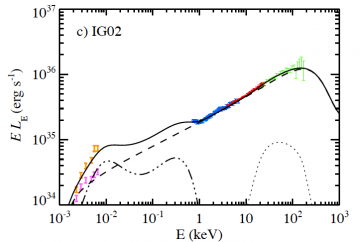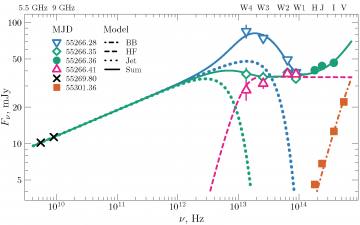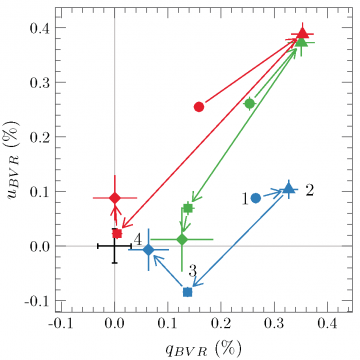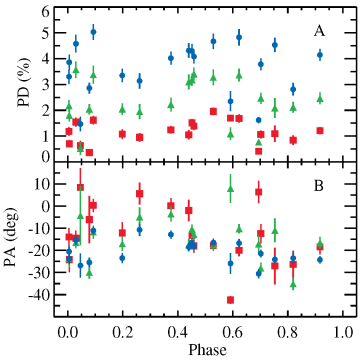Stellar-mass black holes
BHs are among the Universe most enigmatic, powerful and exotic objects. One of the most challenging questions of BH astrophysics is the nature of their emission. There is a general consensus that radio emission is associated with synchrotron radiation from a jet and the X-rays are produced in the vicinity of the compact object in a hot flow by Comptonization of some seed soft photons whose nature is debated. The geometry of the X-ray emitting region is unknown.
The origin of the IR/optical/UV emission from the BH in LMXBs is also not certain. The contribution from the companion star in such systems is usually too faint and the IR/optical spectra are either connected to the jet, or the accretion process onto the compact object. The main focus of our work is the comprehensive analysis of all available sources of information and a construction of physical models consistent with the data.
Our not-so-recent studies concentrated on modelling of the broad-band spectra and temporal properties, in particular the optical-X-ray connection. We have developed the first self-consistent model for spectral formation in BH binaries where photon and electron distributions are computed simultaneously (Vurm & Poutanen 2009). We have shown that emission of non-thermal electrons plays an important role in these objects. Interestingly, the synchrotron self-Compton mechanism operating in the hot accretion flow around BHs is capable of producing their broad-band spectra in the hard state from IR to gamma-rays (Vurm & Poutanen 2008; Poutanen & Vurm 2009; Veledina et al. 2013a). We have shown that both the observed hard-state spectra and their long-term evolution can be explained in terms of the hot accretion flow scenario (Veledina et al. 2013a, Kajava et al. 2016, see Fig. 1)

Figure 1: Example of the observed spectrum in BH X-ray binary SWIFT J1753.5−0127 overlaid with the modelled broadband spectra of hot accretion flow (dashed), irradiated cold accretion disc (dot-dashed) and its reflection (dotted). From Kajava et al. (2016).
We also investigated the nature of variability in stellar-mass BHs: rapid flickering and complex correlation between X-ray and optical (UV, IR) radiation on sub-second time-scales (Veledina et al. 2011, Kajava et al. 2019, Paice et al. 2019, 2021, Vincentelli et al. 2021), quasi-periodic signals in these energy bands (Veledina et al. 2013b, Veledina et al. 2015, Veledina & Poutanen 2015) and optical/IR flares (Poutanen et al. 2014, Kosenkov et al. 2020) during the X-ray state transitions.
Using archival data on an enigmatic accreting BH GX 339−4, recently we showed (Kosenkov et al. 2020b) that the optical/IR flux is produced by three distinct spectral components: a hard blackbody like irradiated disc, a flat component associated likely with the hot accretion flow and a soft component associated with the jet (Fig. 2).

Figure 2: Example of the observed broad-band spectra of BH X-ray binary GX 339−4 using the radio ATCA, mid-IR WISE, and ONIR SMARTS data. The figure shows four distinct spectral shapes for the source. The orange squares show the soft-state data. The filled green circles and open green diamonds indicate the quasi-simultaneous ONIR and mid-IR data during the hard state. The open blue downward-facing triangles and open pink upward facing triangles show the mid-IR spectra measured 1.7 h before and after the quasi-simultaneous observation, respectively. The black crosses indicate one of the closest in time available ATCA radio observations that is used to constrain the jet properties. The lines show different model components: the dot-dashed orange line indicates the blackbody component, the dashed pink line shows the hot flow component, the dotted lines correspond to the jet model with different cutoff frequencies, and the solid lines give the sum of the three (blackbody + hot flow + jet) components. From Kosenkov et al. (2020b).
We have also measured parameters of the BH binary SWIFT J1753.5−0127 (Neustroev et al. 2014) and showed that it hosts a BH of at most 4 solar masses. This result calls into question the recent claims that there is a gap in the mass distribution of the compact objects between 2 to 5 Msun.
Our recent activity involves high-precision optical polarimetric observations of black hole X-ray binaries with DIPol-2 and DIPol-UF polarimeters. We observed V404 Cyg during its last outburst in 2015 and detected significant variations in the position angle of the intrinsic polarization in the R band from −30 deg to 0 deg during the outburst peak (Kosenkov et al. 2017). The observed wavelength dependence of the intrinsic polarization does not support non-thermal synchrotron emission from a jet as a plausible mechanism, but it is in better agreement with the combined effect of electron (Thomson) scattering and absorption in a flattened plasma envelope or outflow surrounding the illuminating source. Interestingly, the position angle of the intrinsic polarization is nearly parallel to the jet direction (i.e. perpendicular to the accretion disc plane). We do not confirm substantial intrinsic polarization found in Shahbaz et al. (2016) and Lipunov et al. (2016). Instead, our results are in agreement with the low intrinsic polarization reported in Tanaka et al. 2016 and Itoh et al. 2017.
In 2018 we observed an outburst of the unique black hole transient MAXI J1820+070. We measured intrinsic polarization of about 0.5% (rising to the red) in the rising hard state (Veledina et al. 2019) with the polarization angle (PA) of 25 deg coinciding with the position angle of the jet. Interestingly, during the soft state the intrinsic polarization degree (PD) dropped to <0.2% with highest PD in the blue (Kosenkov et al. 2020b) and changes the angle to −15 deg (see Fig. 3). High polarization was observed when also signatures of the winds are detected, arguing in favour of the wind as the scattering medium. We then observed the source in quiescence with DIPol-UF at the Nordic Optical Telescope and detected a much higher polarization with very blue spectrum and PD reaching 5% and PA=-20 deg (Fig. 4). Combining this with previous determinations of the relativistic jet orientation axis, which traces the black hole spin, and the inclination of the orbit, we determined a lower limit of 40 deg on the spin-orbit misalignment angle (see Fig.5). The misalignment has to originate from either the binary or black hole formation stage. If other x-ray binaries have similarly large misalignments, these would bias measurements of black hole masses and spins from x-ray observations.

Figure 3: Normalized Stokes q and u parameters observed from MAXI J1820+070 during its outburst. Red, green, blue symbols decode data in the R, V, B bands. Circles and triangles correspond to the rising hard state, squares to the soft state, and diamonds to the decaying hard state. From Kosenkov et al. (2020b).

Figure 4: Observed optical polarization properties of MAXI J1820+070 in quiescence. (A) Intrinsic polarization degree (PD) and (B) polarization angle (PA) are shown as a function of orbital phase. The intrinsic values were obtained from the observed ones by subtracting the foreground interstellar polarization, measured from nearby field stars. Blue circles, green triangles and red squares correspond to B, V , and R bands, respectively, with the error bars showing the 68% confidence level. Polarization is strongest in the B band and weakest in the R band, while the angle does not change substantially. From Poutanen et al. (2022).
Figure 5: Artist impression of the X-ray binary system MAXI J1820+070 containing a black hole (small black dot at the center of the gaseous disk) and a companion star (red). A narrow jet is directed along the black hole spin axis, which is strongly misaligned from the axis of the orbit. Video produced with Binsim (credit: R. Hynes).
For the last two years we were involved in the analysis of the X-ray polarimetric data obtained with the Imaging X-ray Polarimeter Explorer. The first massive stellar remnant studied with this mission was the prototypical black hole X-ray binary Cygnus X-1, which is also the first X-ray source discovered in Cygnus constellation during a rocket flight in 1964, and the first source that was widely accepted to be a black hole. Polarimetric measurements from Cyg X-1, reported on 2022 November 3 volume of Science, revealed a 4% polarization parallel to the radio jet imaged in earlier radio observations (see Fig. 6). This univocally proved that the X-ray emitting gas extends perpendicular to the jet. The data thus rule out previously considered spherical or lamppost models.
The detected high polarization degree also imply that the hot flow might be seen more edge-on than previously thought indicating the misalignment between the black hole spinning axis and the axis of the orbit in which the black hole is rotating around the massive companion. In order to verify this assumption, we performed an observational campaign with the high-precision optical polarimeter DIPol-2, which can say about the direction of the orbital axis on the plane of the sky. However, unlike in MAXI J1820+070, where we have been able to identify a large misalignment seen in the plane of the sky, the binary orbit in Cyg X-1 is very well aligned with the black hole spin axis. Alternatively, the large polarization may indicate that the X-rays are scattered in the outflow that moves away from the black hole at a mildly relativistic velocity. Then due to relativistic aberration, we actually see the scattering region at a different angle in its comoving frame, this increases polarization.

Figure 6: Direction of X-ray polarization of Cyg X-1 as observed by IXPE (orange contours) together with the radio contours identifying the direction of the jet.
Selected publications:
- Veledina A., Poutanen J., Bocharova A., et al.,
Ultrasoft state of microquasar Cygnus X-3: X-ray polarimetry reveals the geometry of astronomical puzzle,
2024, A&A Letters, 688, A27 - Steiner J.E., et al. (incl. Veledina A., Poutanen J., Kravtsov V., Loktev V., Tsygankov S.S.; IXPE collaboration),
An IXPE-Led X-ray Spectro-Polarimetric Campaign on the Soft State of Cygnus X-1: X-ray Polarimetric Evidence for Strong Gravitational Lensing,
2024, ApJL, 969, L30 - Veledina A., Muleri F., Poutanen J., et al. (IXPE collaboration),
Cygnus X-3 revealed as a Galactic ultraluminous X-ray source by IXPE,
2024, Nature Astronomy 8, 1031-1046 - Podgorny J., Svoboda J., Dovciak M., Veledina A., Poutanen J., et al.:
Recovery of the X-ray polarization of Swift J1727.8−1613 after the soft to hard spectral transition,
2024, A&A, 686, L12 - Svoboda J., Dovciak M., Steiner J.F., Kaaret P., Podgorny J., Poutanen J., Veledina A. et al., Dramatic Drop in the X-Ray Polarization of Swift J1727.8–1613 in the Soft Spectral State,
2024, ApJL, 966, L35 - Loktev V., Veledina A., Poutanen J., Nättilä J., Suleimanov V.F.:
artpol: Analytical ray-tracing method for spectro-polarimetric properties of accretion disks around Kerr black holes,
2024, A&A, 685, A84 - Ingram A., Bollemeijer N., Veledina A., Dovciak M., Poutanen J., …, Kravtsov V., …, Loktev V., …, Tsygankov S., et al. (IXPE collaboration),
Tracking the X-ray Polarization of the Black Hole Transient Swift J1727.8-1613 during a State Transition,
2024, ApJ, 968, 76 - Marra L., et al. (IXPE collaboration),
IXPE observation confirms a high spin value in the accreting black hole 4U 1957+115,
2024, A&A, 684, A95 - Ratheesh A., Dovciak M., Krawczynski H., et al. (IXPE collaboration),
The high polarisation of the X-rays from the Black Hole X-ray Binary 4U 1630−47 challenges standard thin accretion disc scenario,
2023, ApJ, 964, 77 - Kaaret P., et al. (IXPE collaboration),
X-ray Polarization of the Eastern Lobe of SS 433,
2024, ApJ Letters, 961, L12 - Svoboda J., et al. (IXPE collaboration),
First X-ray polarization measurement confirms the low black-hole spin in LMC X-3,
2024, ApJ, 960, 3 - Veledina A., Muleri F., Dovciak M., Poutanen J., et al. (IXPE collaboration),
Discovery of X-ray Polarization from the Black Hole Transient Swift J1727.8−1613,
2023, ApJ Letters, 958, L16 - Rodriguez Cavero N., et al. (incl. Veledina A., Poutanen J., Tsygankov S.S.),
The First X-ray Polarization Observation of the Black Hole X-ray Binary 4U 1630−47 in the Steep Power Law State,
2023, ApJ Letters, 958, L8 - Podgorny J., Marra L., Muleri F., et al. (incl. Veledina A., Poutanen J., Tsygankov S.S.),
The first X-ray polarimetric observation of the black hole binary LMC X-1,
2023, MNRAS, 526, 5964-5975 - Poutanen J., Veledina A., Beloborodov A.M.,
Polarized X-rays from windy accretion in Cygnus X-1,
2023, ApJ Letters, 949, L10 - Krawczynski H., Muleri F., Dovčiak M., Veledina A., et al. (incl. also Loktev V., Poutanen J., Berdyugin A., Kravtsov V., Tsygankov S.S.),
Polarized x-rays Constrain The Disk-Jet Geometry in the Black Hole X-ray Binary Cyg X-1,
2022, Science, 378, 650–654 - Poutanen J., Veledina A., Berdyugin A.V., Berdyugina S.V., Jermak H., Jonker P.G.,Kajava J.J.E., Kosenkov I.A., Kravtsov V., Piirola V., Shrestha M., Torres M.A.P., Tsygankov S.S.,
Black hole spin-orbit misalignment in X-ray binary MAXI J1820+070,
2022, Science, 375, 874-876 [arXiv] - Loktev V., Veledina A., Poutanen J.,
Analytical techniques for polarimetric imaging of accretion flows in the Schwarzschild metric,
2022, A&A, 660, A25 - Axelsson M., Veledina A., 2021,
Accretion geometry of the black hole binary MAXI J1820+070 probed by frequency-resolved spectroscopy,
2021, MNRAS, 507, 2744-2754 - Zdziarski A.A., Jourdain E., Lubinski P., Szanecki M., Niedzwiecki A., Veledina A., Poutanen J., Dzielak M.A., Roques J.-P.,
Hybrid Comptonization and Electron-Positron Pair Production in the Black-Hole X-Ray Binary MAXI J1820+070,
2021, ApJ Letters, 914, L5 - Motta S.E., Rodriguez J., Jourdain E., Del Santo M., Belanger G., Cangemi F., Grinberg V., Kajava J.J.E., Kuulkers E., Malzac J., Pottschmidt K., Roques J.P., Sanchez-Fernandez C., Wilms J.,
The INTEGRAL view on black hole X-ray binaries,
2021,New Astronomy Reviews, 93, 101618 - Motta S.E., Kajava J.J.E., et al.,
Observations of a radio-bright, X-ray obscured GRS 1915+105,
2021,MNRAS, 503, 152-161 - Paice J.A., Gandhi P., Shahbaz T., Veledina A. et al.,
The evolution of rapid optical/X-ray timing correlations in the initial hard state of MAXI J1820+070,
2021, MNRAS, 505, 3452-3469 - Vincentelli F.M., Casella P., Russell D., Baglio M.C., Veledina A., et al.,
Fast infrared variability from the black-hole candidate MAXI J1535−571 and tight constraints on the modelling,
2021,MNRAS, 503, 614-624 - Poutanen J.,
Accurate analytic formula for light bending in Schwarzschild metric,
2020, A&A, 640, A24 - Kosenkov I.A., Veledina A., Suleimanov V.F., Poutanen J.,
Colors and patterns of black hole X-ray binary GX 339−4,
2020, A&A, 638, A127 - Kajava J.J.E., Sánchez-Fernández C., Alfonso-Garzón J., Motta S.E., Veledina A.,
Rapid spectral transition of the black hole binary V404 Cygni,
2020,A&A, 634, A94 - Kosenkov I.A., Veledina A., Berdyugin A.V., Kravtsov V., Piirola V., Berdyugina S.V., Sakanoi T., Kagitani M., Poutanen J.,
Disc and wind in black hole X-ray binary MAXI J1820+070 observed through polarised light during its 2018 outburst,
2020, MNRAS Letters, 496, L96-L100 - Paice J.A., Gandhi P., Shahbaz T., … Veledina A.,
A black hole X-ray binary at ∼100 Hz: multiwavelength timing of MAXI J1820+070 with HiPERCAM and NICER,
2019,MNRAS, 505, 3452-3469 - Kajava J.J.E., Motta S.E., Sanna A., Veledina A., Del Santo M., Segreto A.,
X-ray dips and a complex UV/X-ray cross-correlation function in the black hole candidate MAXI J1820+070,
2019, MNRAS Letters, 488, L18-L23 - Muñoz-Darias T., …., Kajava J.J.E., et al.,
Hard-state Accretion Disk Winds from Black Holes: The Revealing Case of MAXI J1820+070,
2019, ApJL, 879, L4 - Veledina A., Berdyugin A.V., Kosenkov I.A., Kajava J.J.E., Tsygankov S.S., Piirola V., Berdyugina S.V., Sakanoi T., Kagitani M., Kravtsov V., Poutanen J.,
Evolving optical polarization of the black hole X-ray binary MAXI J1820+070,
2019, A&A, 623, A75 - Kajava J.J.E., Motta S.E., Sánchez-Fernández C., Kuulkers E.,
The December 2015 re-brightening of V404 Cygni. Variable absorption from the accretion disc outflow,
2018, A&A, 616, A129 - Kosenkov I.A., Veledina A.,
Superhump period of the black hole X-ray binary GX 339-4
2018, MNRAS, 478, 4710-4719, - Poutanen J., Veledina A., Zdziarski A.A.,
Doughnut strikes sandwich: the geometry of hot medium in accreting black hole X-ray binaries,
2018, A&A, 614, A79 - Veledina A.,
Interplay of spectral components in timing properties of accreting compact objects,
2018, MNRAS, 4236-4249 - Veledina A., Gandhi P., Hynes R., Kajava J.J.E., Tsygankov S.S., Revnivtsev M.G., Durant M., Poutanen J.,
Expanding hot flow in the black hole binary SWIFT J1753.5−0127: evidence from optical timing,
2017, MNRAS, 470, 48-59 - Kosenkov I.A., Berdyugin A.V., Piirola V., Tsygankov S.S., Palle E., Miles-Paez P.A., Poutanen J.,
High-precision optical polarimetry of the accreting black hole V404 Cyg during the 2015 outburst,
2017, MNRAS, 468, 4362-4373 - Kajava J.J.E. Veledina A., Tsygankov S., Neustroev V.,
The origin of seed photons for Comptonization in the black hole binary Swift J1753.5-0127,
2016, A&A, 591, A66 - Veledina A.,
Interference as an Origin of the Peaked Noise in Accreting X-Ray Binaries,
2016, ApJ, 832, 181 - Veledina A., Revnivtsev M.G., Durant M., Gandhi P., Poutanen J.,
Discovery of correlated optical/X-ray quasi-periodic oscillations in black hole binary SWIFT J1753.5–0127,
2015, MNRAS, 454, 2855-2862 - Ingram A., Maccarone T.J., Poutanen J., Krawczynski H.,
Polarization modulation from Lense-Thirring precession in X-ray binaries,
2015, ApJ, 807, 53 - Veledina A., Poutanen J., ,
Reprocessing model for the optical quasi-periodic oscillations in black hole binaries,
2015 MNRAS, 448, 939-945 - Poutanen J., Veledina A., Revnivtsev M.G.,
Colours of black holes: infrared flares from the hot accretion disc in XTE J1550−564,
2014, MNRAS, 445, 3987-3998 - Neustroev V.V., Veledina A., Poutanen J., Zharikov S.V., Tsygankov S.S., Sjoberg G., Kajava J.J.E.,
Spectroscopic evidence for a low-mass black hole in SWIFT J1753.5−0127,
2014, MNRAS, 445, 2424-2439 - Poutanen J., Veledina A.,
Modelling spectral and timing properties of accreting black holes: the hybrid hot flow paradigm,
2014, Space Science Reviews, 183, 61-85 - Veledina A., Poutanen J., Ingram A.,
A unified Lense-Thirring precession model for optical and X-ray quasi-periodic oscillations in black hole binaries,
2013, ApJ, 778, 165 - Veledina A., Poutanen J., Vurm I.,
Hot accretion flow in black hole binaries: a link connecting X-rays to the infrared,
2013, MNRAS, 430, 3196-3212 - Veledina A., Poutanen J., Vurm I.,
A synchrotron self-Compton – disk reprocessing model for optical/X-ray correlation in black hole X-ray binaries,
2011, ApJL, 737, L17 - Poutanen J., Vurm I.,
On the origin of spectral states in accreting black holes,
2009, ApJL, 690, L97-L100 - Vurm I., Poutanen J.,
Time-dependent modelling of radiative processes in hot magnetized plasmas,
2009,ApJ, 698, 293-316